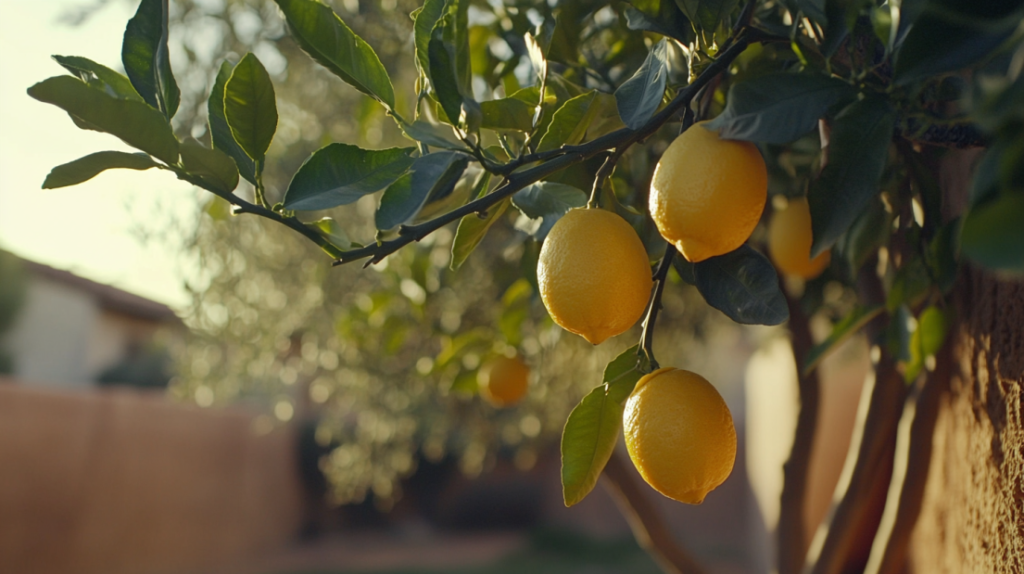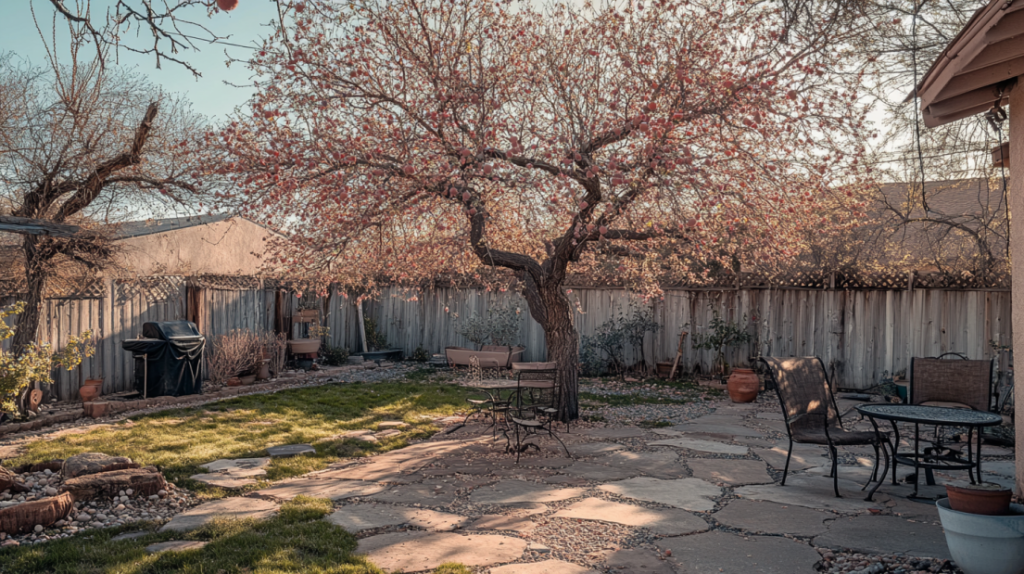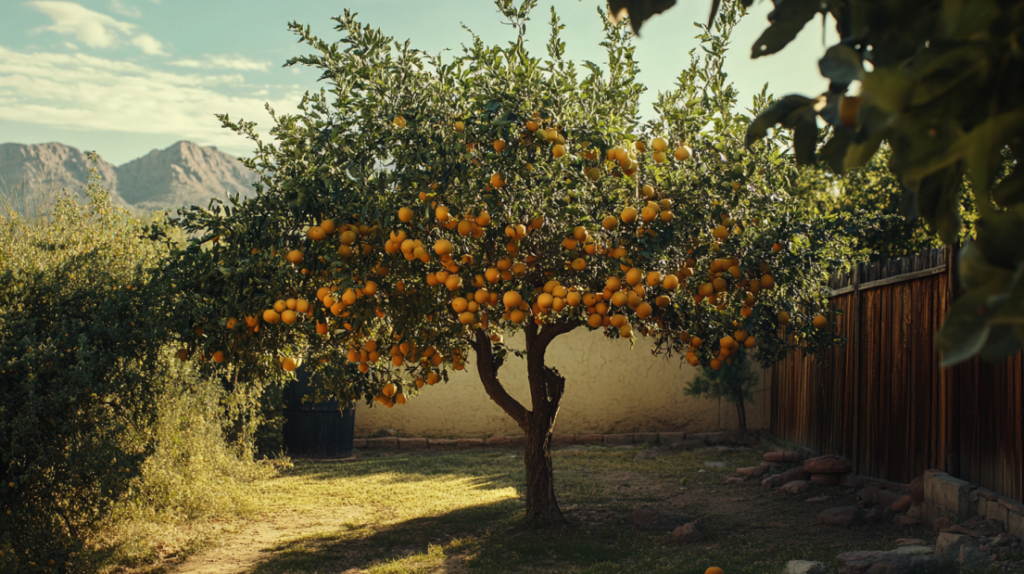Looking to add some fruit trees to your Arizona backyard? With the right selection, you can enjoy fresh, homegrown fruit despite the desert climate. In this article, we’ll explore nine fruit trees that thrive in Arizona’s unique conditions, making it easier to grow your own delicious harvest right at home.
Whether you’re new to gardening or looking to expand your orchard, these picks will help you enjoy the benefits of fresh fruit with minimal fuss.
Arizona’s Climate An It’s Impact On Growing Fruit Trees
Arizona’s climate presents unique challenges and opportunities for growing fruit trees. The state features a range of climatic zones, primarily characterized by hot summers, mild winters, and varying levels of rainfall.
Temperature
Summer temperatures often exceed 100°F. The heat can stress unprepared plants, leading to lower yields. In contrast, winter temperatures can drop to the mid-30s°F in some areas. Choose trees that handle both extremes.
Rainfall
Rainfall in Arizona varies by region. The average annual precipitation ranges from 3 to 40 inches. Many areas experience summer monsoons, providing brief, heavy rains. Proper irrigation strategies become essential to support your fruit trees.
Soil Types
Soil types differ throughout the state. Sandy soils dominate the desert areas while clay soils are common in the northern regions. Assessing your soil type helps determine the right amendments for optimal fruit tree growth.
Sun Exposure
Full sun exposure is vital for most fruit trees. Aim for 6-8 hours of direct sunlight daily. Trees like citrus and stone fruits thrive under these conditions, while some may require partial shade during peak summer.
- Watering: Implement efficient watering systems, such as drip irrigation, to minimize water waste.
- Fertilizing: Use organic fertilizers to promote healthy growth and production.
- Mulching: Apply mulch to retain moisture and regulate soil temperature.
Understanding Arizona’s climate is crucial for selecting and nurturing the right fruit trees. With the correct knowledge and approach, you can enjoy a fruitful harvest from your backyard oasis.
Popular Fruit Trees in Arizona
Arizona’s warm climate supports a variety of fruit trees that thrive in its unique environment. Selecting the right trees can lead to bountiful harvests.
Citrus Trees

Citrus trees excel in Arizona’s climate. They prefer well-drained soil and full sun. Common citrus varieties include:
- Orange Trees: Sweet navel oranges grow well and produce fruit in late winter and spring.
- Lemon Trees: Meyer lemons thrive and offer a fragrant bloom alongside their tart fruit.
- Grapefruit Trees: Grapefruit trees produce large, juicy fruits and are hardy even in higher temperatures.
Implement efficient irrigation methods, as citrus trees require consistent moisture, especially during the scorching summer months. Regular pruning helps maintain shape and encourages increased fruit production.
Stone Fruit Trees

Stone fruit trees also flourish in Arizona. These trees thrive in the warmer regions, bringing a diverse range of flavors. Popular options are:
- Peach Trees: Varieties like ‘Arizona’ and ‘Tropics’ grow well, yielding sweet peaches around mid to late summer.
- Apricot Trees: Apricots mature quickly and enjoy sunny locations; select varieties like ‘Katy’ or ‘Tilton’.
- Plum Trees: Choose varieties such as ‘Santa Rosa’ or ‘Methley’ for an abundant fall harvest.
These trees benefit from well-drained soil and regular watering, especially during dry spells. Fertilizing with balanced nutrients supports healthy growth.
Tropical Fruit Trees

Tropical fruit trees add a unique touch to your Arizona garden. These trees often require more care but yield exotic fruits that are rewarding. Consider these options:
- Banana Trees: Bananas thrive in warm temperatures and produce fruit in about 9 to 15 months. Provide ample water and protection from cold drafts.
- Papaya Trees: Fast-growing papaya trees can bear fruit within a year. They need full sun and well-drained soil.
- Guava Trees: Guava trees prefer sunny spots and produce sweet, fragrant fruits, typically in late summer or early fall.
Tropical trees often need more water and can benefit from mulch to retain moisture. Ensure they’re sheltered from harsh winds to protect delicate foliage.
By choosing suitable fruit trees and providing proper care, you’ll enjoy a fresh bounty from your Arizona backyard.
Considerations for Growing Fruit Trees
Growing fruit trees in Arizona requires understanding specific environmental factors. Attention to soil, watering, and pest management plays a crucial role in successful cultivation.
Soil Types and Preparation
Evaluate your soil type before planting. Arizona has diverse soil conditions, including sandy, loamy, and clay soils.
- Sandy Soil: Drains quickly, requires frequent watering.
- Clay Soil: Retains moisture, may need better drainage.
- Loamy Soil: Ideal balance for most fruit trees, offering good drainage and moisture retention.
Amending soil with organic matter enhances nutrient content. Compost enriches sandy soil, while gypsum improves clay soil structure. Always test soil pH to ensure it’s within the suitable range of 6.0 to 7.5 for most fruit trees.
Watering Needs
Understand watering requirements specific to Arizona’s climate.
- Deep Watering: Water trees deeply a couple of times per week, allowing roots to grow deeper.
- Morning Access: Water in the morning to reduce evaporation.
- Drip Irrigation: Consider using drip irrigation for efficiency, delivering moisture directly to the root zones.
Monitor soil moisture with your fingers; if it feels dry a couple of inches below the surface, it’s time to water.
Pest and Disease Management
Pest control in Arizona requires vigilance. Regularly inspect your trees for early signs of pest infestations or diseases.
- Common Pests: Watch for aphids, spider mites, and leaf hoppers.
- Preventive Measures: Use row covers or introduce beneficial insects like ladybugs to control pest populations.
- Disease Awareness: Be alert for signs of fungal infections; proper air circulation helps prevent these issues.
Incorporate organic pest control methods, such as neem oil or insecticidal soap, if problems arise. Regular maintenance ensures healthy fruit trees, leading to a plentiful harvest.
Tips for Success in Arizona
Growing fruit trees in Arizona requires specific strategies to ensure their thriving in the desert climate. Focus on the following aspects to maximize your success.
Choosing the Right Varieties
Select fruit tree varieties that tolerate high temperatures and low humidity. Consider these options:
- Citrus Trees: Oranges, lemons, and limes thrive in Arizona’s heat. They prefer well-drained soil and need regular watering.
- Stone Fruit Trees: Peaches, apricots, and plums perform well in sunny spots. Ensure consistent moisture and balanced fertilization for optimal growth.
- Tropical Fruits: Bananas and guavas require more attention. Provide extra water and protect these trees from strong winds.
Research local plant nurseries for varieties suited to your specific region. Ask experts about selections that perform best in your area.
Seasonal Care
Seasonal care plays a vital role in the success of your fruit trees. Follow these guidelines:
- Spring: Fertilize with an organic fertilizer to promote growth as temperatures rise. Begin a regular watering schedule to support new foliage and fruit development.
- Summer: Monitor soil moisture closely. Water deeply at least once a week to encourage strong root systems. Mulch around trees to retain moisture and control weeds.
- Fall: Prepare for winter by reducing watering frequency. As temperatures cool, prune trees to remove dead or diseased branches. This step encourages healthy growth in the spring.
- Winter: Protect young trees from frost by wrapping trunks or using frost cloth. Check soil moisture levels; if needed, water sparingly during dry spells.
By understanding your trees’ seasonal needs, you can ensure healthy growth and a bountiful harvest. Aim to adapt your care routine based on weather conditions and tree responses for the best results.
Conclusion
Growing fruit trees in Arizona can be a rewarding experience. With the right choices and care you can enjoy fresh produce right from your backyard. Remember to consider your specific climate and soil conditions when selecting your trees.
By focusing on varieties that thrive in the heat and implementing effective watering and care strategies you’ll set yourself up for success. Whether you opt for citrus trees or explore the world of stone and tropical fruits there’s a delicious adventure waiting for you. Embrace the journey and get ready to savor the fruits of your labor!
Frequently Asked Questions
What fruit trees can I grow in Arizona’s climate?
Many fruit trees thrive in Arizona’s unique climate, including citrus varieties like oranges, lemons, and grapefruits. Stone fruits such as peaches, apricots, and plums are also suitable. For tropical options, consider bananas, papayas, and guavas, though they require extra care and water.
How should I water my fruit trees in Arizona?
Deep watering is essential in Arizona’s climate. Using drip irrigation ensures that water reaches the tree roots effectively while reducing waste. Focus on consistent moisture, especially during the hot summer months.
What soil types are found in Arizona for growing fruit trees?
Arizona has varied soil types, including sandy soils in desert regions and clay soils in the northern areas. Assessing your soil type is crucial for successful fruit tree growth, and amending it with compost can improve drainage and nutrients.
How do I manage pests for my fruit trees?
Regular inspections are key to managing pests. Look out for common pests and use organic control methods, such as insecticidal soap or neem oil, to keep your trees healthy without harmful chemicals.
What are some tips for successful fruit tree cultivation?
Choose heat-tolerant varieties and ensure they get full sun exposure. Seasonal care is important: fertilize in spring, water consistently in summer, prune in fall, and protect against frost in winter for optimal growth and harvest.

